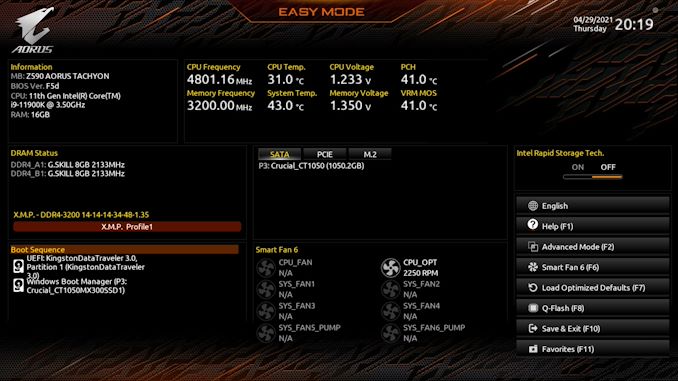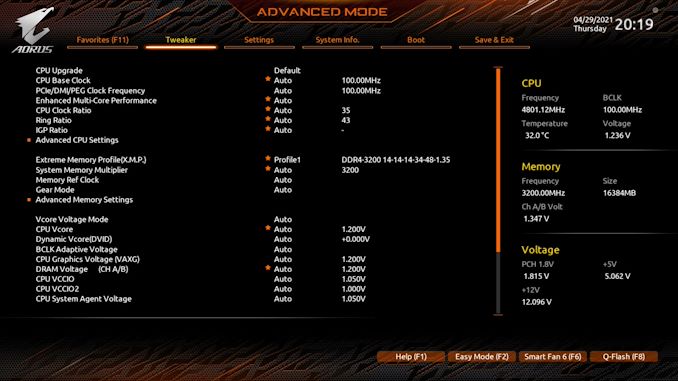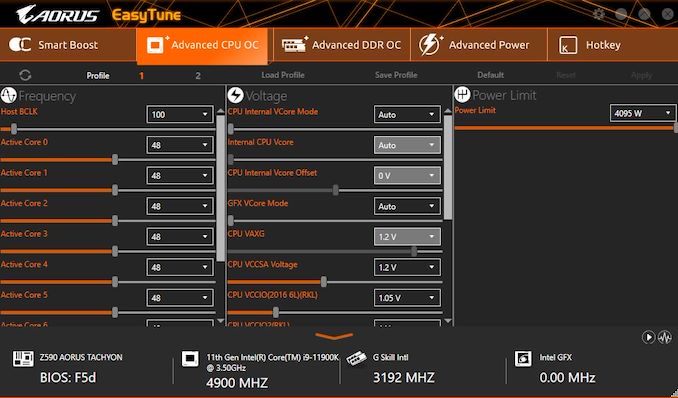GIGABYTE Z590 Aorus Tachyon Review: Built for SPEED
by Gavin Bonshor on May 10, 2021 9:30 AM ESTBIOS
The GIGABYTE UEFI firmware has remained consistent throughout the previous generations on both Intel and AMD models. Looking at the design, GIGABYTE is using a primarily black background with orange accents, white text and fits in with its Aorus gaming theme. The Z590 Aorus Tachyon BIOS has two primary modes, Easy Mode and Advanced Mode.
Entering the firmware upon system POST and pressing the F2 key will bring users into the Easy Mode area of the firmware. The Easy Mode is designed for users without much experience in customization options in the firmware. Also, it provides a lot of useful information and access to functional areas of the BIOS. In the top left-hand corner is a basic list of information which includes the model (Tachyon), the firmware version, the installed processor, and the total capacity of the memory installed. Below is an option for users to enable X.M.P 2.0 memory profiles. On the right-hand side is a list of hotkey indicators, including a help menu that can be accessed by pressing the F1 key, the Smart Fan 6 utility, which can be accessed by pressing the F6 key, while pressing the F2 key allows users to enter the Advanced Mode.
Entering the advanced mode, which can be done by pressing the F2 key when in the firmware, allows access to all of the board's overclocking, chipset, power, and security options. The Tweaker section hosts the Tachyon's extensive overclocking features, including options for adjusting the CPU frequency, Cache frequency, integrated graphics frequency, and all of the relevant voltage settings. For memory, GIGABYTE includes extensive memory overclocking options, including ratio adjustment and latency options, as well as Intel's new Gear Mode, which allows the integrated memory controller to operate at half the speed of memory in a 2:1 or 1:1 ratio, which should theoretically allow for more aggressive frequency overclocks. There's also a section within the Advanced CPU Sections sub menu for adjusting the loadline calibration profile for more aggressive or slacker VDroop control.
Given the obvious overclocking infused pedigree of the Z590 Aorus Tachyon, GIGABYTE provides an easy and intuitive firmware that is also responsive. The functionality of both the Easy and Advanced modes allows users of all experience levels access to key functions such as the Smart Fan 6 utility and flashing the firmware through the BIOS.
Software
GIGABYTE includes a wide variety of software and utilities with the Z590 Aorus Tachyon, which all focus around the Aorus App Center, which acts as a centralized hub for all of GIGABYTE's installed software, Windows related settings, and also third party software. Some of the most notable applications include the EasyTune software, the RGB Fusion 2.0 software for customizing the aesthetic of the board, and the System Information Viewer (SIV) utility.
Perhaps the most interesting and intuitive piece of software in the bundle is the Aorus EasyTune software. This allows users to perform overclocks to both the CPU and memory within Windows. There are options for adjusting the CPU frequency ratio, base clock frequency (BLCK), and various voltages, including CPU VCore, CPU VCCSA, and VCCIO. The EasyTune software also allows users to overclock the memory, including memory frequency and primary latency timings. Users can alter power settings such as CPU VCore current protection values, the CPU VCore load-line calibration profile, CPU VCore protection, and CPU VAXG protection.
Other useful software applications include the RGB Fusion 2.0 utility, which allows users to customize the strip of integrated RGB LEDs on the Tachyon, and the four RGB headers located around the board's edge. The System Information Viewer or SIV application provides an informative list of installed hardware. Also, it allows users access to the Smart Fan 6 utility, where users can customize fan profiles depending on the levels of cooling performance required.
The software package supplied with the GIGABYTE Z590 Aorus Tachyon omits any audio software, although users can download the Realtek Control Center from the Microsoft store.

























15 Comments
View All Comments
just_passin_by_2 - Tuesday, May 24, 2022 - link
Glass could also break or shatter dangerously*just_passin_by_2 - Tuesday, May 24, 2022 - link
so safety glasses could also be goodSlash3 - Monday, May 10, 2021 - link
You've got the PCI Express slot assignment listed incorrectly on the conclusion (possibly elsewhere).The slots are, from top to bottom:
Gen3 x4 (chipset)
Gen4 x16 (CPU)
Gen4 x8 (CPU, switched with second slot)
Gen3 x1 (chipset)
https://download.gigabyte.com/FileList/Manual/mb_m...
Amazing board, awful availability.
Silver5urfer - Monday, May 10, 2021 - link
Can I know what revision of the chip this board is using for the Intel 225V Foxville chip ? SLNMH or SLMNG ? If any of those then GB is using the B3 stepping, which is there on ASUS Maximus Z590 lineup as well. Revised one which doesn't have HW issues like prev ones.Also I hope you guys can get the Z590 DARK. The Z590 FTW is out already, why do you guys do not recommend any ASUS Maximus or Dark boards at all ?
jeremyshaw - Monday, May 10, 2021 - link
I would really hope Intel fixed the <10Mbps issue by the 3rd stepping.